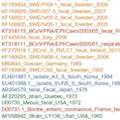Abstract
Bovine coronavirus (BCoV) is widespread in cattle and wild ruminant populations throughout the world. The virus causes neonatal calf diarrhea and winter dysentery in adult cattle, as well as upper and lower respiratory tract infection in young cattle. We isolated and deep sequenced whole genomes of BCoV from calves with respiratory distress in the south–west of France and conducted a comparative genome analysis using globally collected BCoV sequences to provide insights into the genomic characteristics, evolutionary origins, and global diversity of BCoV. Molecular clock analyses allowed us to estimate that the BCoV ancestor emerged in the 1940s, and that two geographically distinct lineages diverged from the 1960s–1970s. A recombination event in the spike gene (breakpoint at nt 1100) may be at the origin of the genetic divergence sixty years ago. Little evidence of genetic mixing between the spatially segregated lineages was found, suggesting that BCoV genetic diversity is a result of a global transmission pathway that occurred during the last century. However, we found variation in evolution rates between the European and non-European lineages indicating differences in virus ecology.
